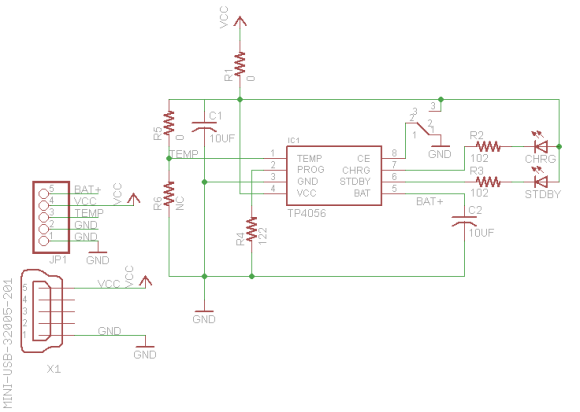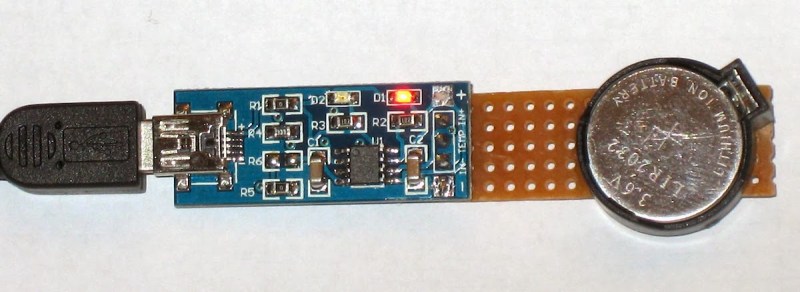Sure, coin cells usually last a long time — but do you really want to buy new ones and throw the old ones out? The LiR2032 coin cell is a rechargeable lithium battery, for which you can build a charger at around $1.
The 5 minute hack starts with a TP4056 lithium charging circuit, which is a great DIY board designed to charge high-capacity cells at about 1A. Luckily, it is pretty easy to modify the board to charge lower capacity batteries. It’s just a matter of replacing resistor R4, and a little bit of soldering!
The official TP4056 datasheet even tells you the range of resistors to use (page 3). [Tom] went below that range and found a 33KΩ will result in about a 50mA output — this results in a full (and safe) charge of the LiR2032 in just over an hour.
To finish up the hack he soldered a piece of strip board to the charging header, and attached a coin cell holder. Not bad for a buck. Now what if you added a few resistors and a dip switch too? It’d be pretty easy to make an all in one lithium charger!
















Actually the LiR2032 has a capacitance around 40mA and the recommended current for charging safely lithium cells should be 80% or less of their capacity. 35mA is the maximum safe charging current for LiR2032 cells, as indicated on the battery datasheet, therefore 50mA is too high and not safe at all.
It depends on the brand. I’ll show you my datasheet if you show me yours :) Watch out for commercial coin cell chargers that supply 150 mA.
This is exactly my point: when dealing with something potentially dangerous we should always trade speed for safety. The user might know nothing about data sheets and should never be forced to check them, therefore one designs the charger for the lowest and safest current. By the way, slow charging also prolongs battery life.
I also would stay away from anything that pumps 150 mA into a coin cell, if such a charger really exists, unless I’m doing IED research:)
Such a charger is certainly advertised, but I would not be surprised if the specs are wrong. Check out the “Smart Charger” on www dot batteryspace dot com. You are right that you can’t go wrong by charging slower, except that the Sun will soon die and engulf the planet.
You can’t go wrong when you make sure to plan ahead…
The datasheet suggests a linear progression of doubling the resistor value will halve the output current. The formula mentioned is battery current = (1v / resistor value) * 1200. With that formula, 33k would give about 36mA. The only concern I have is the datasheet also mentions a range of +/- 50mA for the two values (1.2k and 2.4k) that they list in the electrical characteristics. That suggests to me that shooting for charge currents in the tens of mA will be dicey at best.
Presuming the table in the datasheet is valid., if you do the math, you’d find that the 33Kohm resistor would result in 36.37mA charge rate, which is in the ballpark of the figure you cite as a safe rate. I don’t know where the 50mA figure comes from in the summary – computed or measured? measured at the INPUT to the circuit (which would include parasitic loads such as the LED), or output?
Checking the values in the table shows them to be linear. Using the max rate of 1000mA with 1200 ohms, one can do the following:
1000 * 1200 / (desired_charge_rate) = (necessary_resistance).
The two variables cab be swapped for solving for whichever is the unknown. You can test it easily by checking the other charge rates. Some of the resistance values are clearly rounded (and are not standard E24 values).
I should clarify the equation in my earlier reply: the desired charge rate is expressed in mA not A (i.e. 50mA = 50, not 0.050, and 1A = 1000). So:
1000 * 1200 / (desired_charge_rate_in_mA) = (necessary_resistance_in_ohms)
Given a resistor you have on hand, or is already in a circuit (say a 223, which is 22K ohm, which would be 54.55mA):
1000 * 1200 / (resistor_in_ohm) = (charge_rate_in_mA)
I have that exact same Charger PCB from ebay (china). The vendor didn’t wrote much about the features and I’m still wondering why R6 is not populated. Is it to tinker with resistor values to achieve a different output? If so, is there a Lookup List of some kind?
Well, it looks like the table exists in the Datasheet :D
R6 is most likely for a thermistor.
According to information from the vendor “R5 and R6 control the risky battery temperature range” when pin 1 (TEMP) is connected to a NTC thermistor in the battery pack. Grounding pin 1 (using R6 = 0R) disables the temperature sense function.
That’s neat an all, but you can buy cr2032’s from digikey for $.40 apiece. granted it makes a difference in aggregate but if you want to be sure of it, new is better.
3v != 3.6v
3v < 3.6v !
Also importantly, 35-40mAH != 225mAH. It’s a fifth of the capacity, which substantially increases the pain-in-the-ass factor.
&& rechargable != as_much_trash
(something it does not hurt to consider)
and what’s the self discharge of an LiR2032 ?
I have only one gripe with rechargeable battery’s and that the self discharge.
found a data sheet that suggests for a 35mAh discharge type it’s still should be at 85% (or more) after that. yeah, maybe with brand new one…
thank god for eneloop battery’s in the AAA/AA range…
damn , no edit should read ” for a 35mAh discharge type it’s still should be at 85% (or more) after 28 day’s”
sheet: http://www.powerstream.com/p/Lir2032.pdf
Yeah not particularly amazing. I am designing a low power blinky light thing using an LiR2032 and that is a significant limitation. CR2032 would not work because it needs 3.6V to drive UV LEDs.
While on the topic: I have a 3.7V LiPo with 240mAh.
As I understand it, this charger has a termination voltage of around 4.2V. Would it be somehow possible to still charge this 3.7V LiPo with this charger by modifying the components?
TP4056 should be fine to charge a LiPo. Typically you would charge at 1C i.e. 240 mA. So you’d use something like a 5.1K resistor for R4.
Thank you for your reply. To get thi straight: The chargerwill not damage the LiPo? Because in the Datasheet it says “Preset 4.2V Charge Voltage” and my LiPo says 3.7V (It is even 3.8V on full load).
4.2V is the usual charging voltage for a LiPo, it won’t damage the cell unless the current is too high or you overcharge the battery.
Thank you for your feedback on that topic. I will whip out my iron right now :)
Can the micro usb port be used to charge and discharge the cell?
(1) It’s mini USB but yes, plug into a USB port to charge. (2) Use a resistive load to discharge.
How robust is the TP4056?
Ages ago I bought a bunch of Microchip MCP73831-2 /OT chips for safely recharging lithium cells, but discovered they die too easily if accidentally shortcircuited so my adventures into rechargable lithium cell powered circuits came to a halt, and I want to get back into that area especially as you can buy 10 of those TP4056 boards for about $9 from a Chinese eBay seller.
TP4056 is a great little chip. Proper CC/CV li-ion charge curve.
http://budgetlightforum.com/node/13913
My RC car days made me just as worried about under-charging a LIPO as charging them. You don’t want to drop them below 3v per cell. I assume these coin cells don’t have built in auto cut offs.
I guess there must be modules out there which have another two pins for ‘load’, with safety cut off and allow charging with the load connected?
I have recently seen a charger module with a protection circuit on the same board. No luck finding it tho. Protection circuits are available that you can add on.
They certainly don’t have any low voltage cut-off circuitry, I have a couple of torches (one solar charged, another wind-up charged) with dead LIR2032s because the voltage got too low, the torches were very cheap so had no protection circuitry, they just won’t hold charge anymore.
Yes watch out for that, especially if you are just swapping LiR2032 for a nonrechargeable CR2032. Fortunately LiR2032s are affordable enough that you can afford to kill a few.
Does anyone know of a good writeup on rechargeable batteries? Every time something like this pops out it reminds me I know nothig about it (except to avoid the usuall warnings and the stuff that’s on wikipedia)
Here is a review of the new charger module with a protection circuit: https://www.youtube.com/watch?v=Qw4psECqpwI&list=UUmHvGf00GDuPYG9DZqQKd9A
I created a LIR2450 USB charger using the MCP73831: https://github.com/cgrossde/LIR2450-USB-Charger
Boards did not arrive yet. What do you think?
Can anybody please tell me where can i buy TP4056 online ?
Got to —
http://www.dhgate.com/store/product/supply-electronic-components-tp4056-1a-linear/212392562.html#se1-0-1a|941307563
Go to:
http://www.dhgate.com/store/product/supply-electronic-components-tp4056-1a-linear/212392562.html#se1-0-1a|941307563
Need a charger for CR1220 3Volt 40mAh Coin Battery.
I was looking for a 1220 battery charger all over the net and they do not exist. The Closest I could find is a 3.7V 150mA charger at http://www.batteryspace.com/smartcharger150mafor37vli-ionpolymerrechargeablebattery–cellphonesipod.aspx
My question is can I use this charger to recharge 1220 or do I have to add a resistor to the Negative side before I can safely charge the coin battery?
Many thanks for and ideas you may have.
i am wondering if it does charge ML2032 (3V) battery?
what should be the exact value for different resistors used?
i used TP4056 charching circuit. it is possible to recharge ML2032 battery with it?
So if I wanted to connect two of these batteries in a series for 7.2v do you know what I’d have to do to the charger to achieve this? I feel like its a strange question but I wanted to use two batteries to power a couple of LEDs and in the process and mount them so I wouldn’t have take them out individually to charge them.
Could this be made to recharge Li-ion 1220 batteries?
Ideally a USB interface coin cell charger — is it possible?